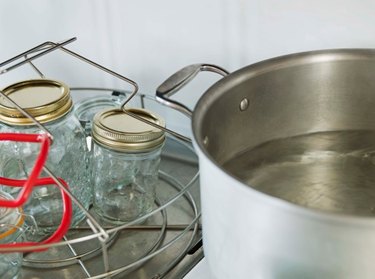
Start with clean, sterilized jars to help ensure that your canning project produces delicious foods that your family can enjoy -- safely -- for months. While it may be tempting to sterilize the jars in the dishwasher, this convenient appliance uses water that is not hot enough to safely sterilize jars. Proper sterilization requires just one more step, however; one that utilizes accessories you already have for the canning process.
Recommended Sterilization Temperature
Video of the Day
Jars must be fully submerged for 10 minutes in boiling water (212 degrees Fahrenheit) for safe sterilization. The highest temperature for the water in most home dishwashers is 140 degrees Fahrenheit, which will not sterilize jars no matter how long the dishwasher cycle runs.
Video of the Day
Safe Sterilization Technique
Wash the jars in hot water by hand, or run them through a cycle in the dishwasher. Place the clean, empty jars in a canner or a large stock pot and cover the jars with hot (not boiling) water, making sure the tops of the jars are below the water's surface by at least 1 inch. Bring the water to a boil, and boil the jars for 10 minutes. Remove the sterilized jars with canning tongs while they are still hot, and drain. Place the hot jars on a clean dish towel and immediately begin the canning process.
When to Sterilize
If you are canning any food, such as jelly, jam or pickles, that will be processed for less than 10 minutes in a boiling water canner, you must sterilize the jars before putting food in them. You do not have to sterilize jars that will be processed in a pressure canner.
Dangers of Improper Sterilization
Unsterilized jars may harbor invisible microbes that can spread through the canned food. These microbes can alter the taste and texture of the food, and may lead to illness if the food is consumed. If the food in a jar shows any sign of mold of discoloration, put the top back on and discard. Also discard any jars that have swollen lids. Never taste discolored food to ascertain whether it is safe; illness-inducing microbes may be tasteless.